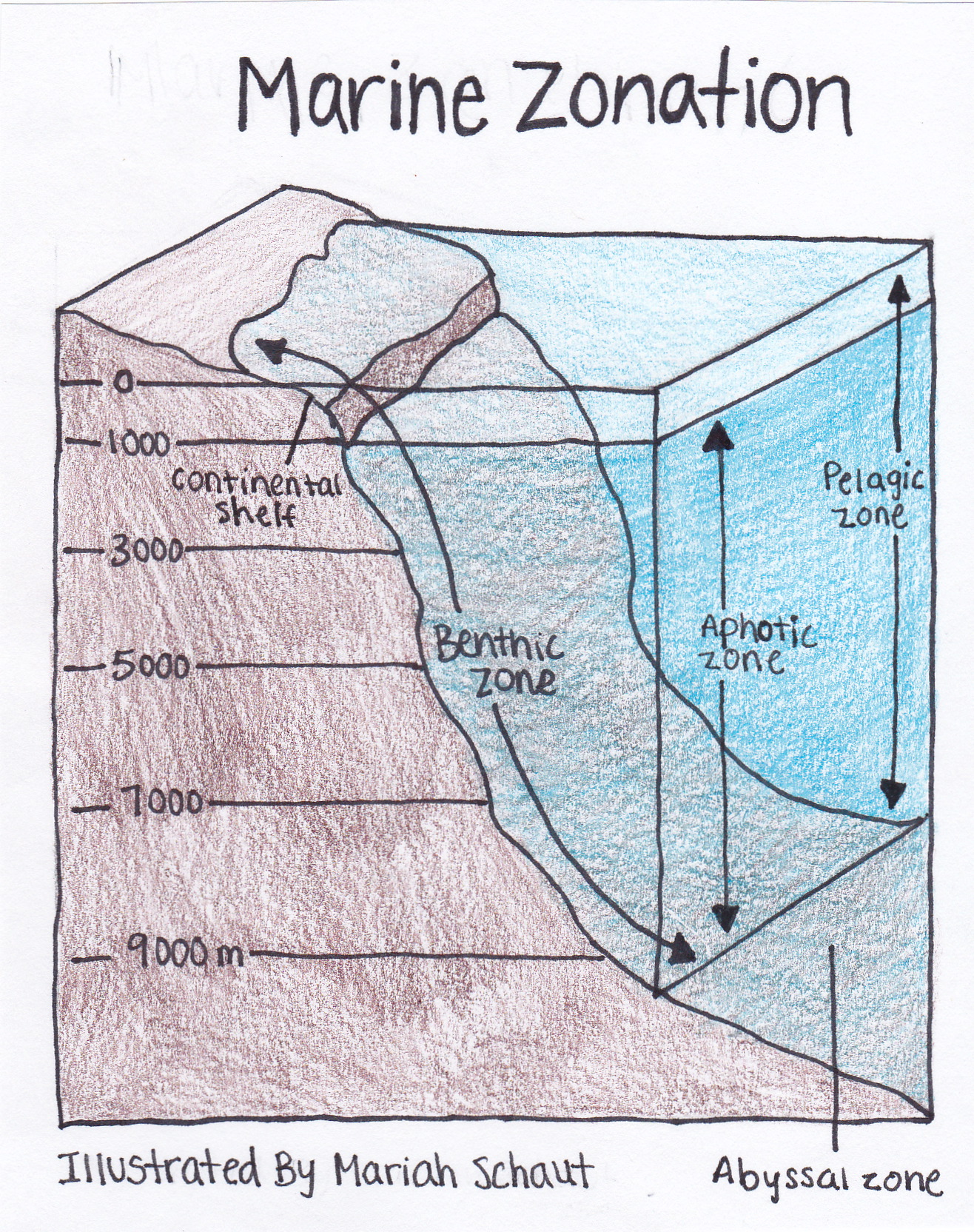Habitat
Odontosyllis phosphorea live in shallow coastal areas down
near the benthic level of salt-water oceans (Deheyn and Latz,
2009). The benthic level of the ocean is defined as the bottom
surface of an aquatic environment (Campbell G-4, 2008).
Odontosyllis phosphorea have been found to live off the coast of California, Oregon, Washington, parts of British Columbia Canada
and off the coasts of Panama (Figure 1.) ("Odontosyllis phosphorea," 2013).
Odontosyllis live on hard surfaces such as rocks in sandy areas
or in beds of sea grass (Siebert, 2009). Adult and juvenile
worms create a half cylinder parchment-like tube on rocks or
heavy solid surfaces (Jones and Wood, 2006). The rocks act as a
weight for the O. phosphorea to stay down in the depths of the
ocean (Pickett, 2012). The only time these worms leave the
benthic level is to reproduce (Tsuji and Hill, 1983). More of
the reproductive ritual is explained on the
life cycle page.
California, Oregon, Washington, parts of British Columbia Canada
and off the coasts of Panama (Figure 1.) ("Odontosyllis phosphorea," 2013).
Odontosyllis live on hard surfaces such as rocks in sandy areas
or in beds of sea grass (Siebert, 2009). Adult and juvenile
worms create a half cylinder parchment-like tube on rocks or
heavy solid surfaces (Jones and Wood, 2006). The rocks act as a
weight for the O. phosphorea to stay down in the depths of the
ocean (Pickett, 2012). The only time these worms leave the
benthic level is to reproduce (Tsuji and Hill, 1983). More of
the reproductive ritual is explained on the
life cycle page.
Figure 1. Locations Odontosyllis phosphorea have been found. (Modified by Isaac Metzler, 2013)
Benthos describes the communities that live in the benthic level of the ocean (Figure 2.) (Campbell G-4, 2008). Odontosyllis phosphorea is considered to be in this group along with other animilia like sponges, cnidarians, bristlworns, molluscs, crustasceans and echinoderms (Valtýsson, n.d.). Take a look at, Mastocarpus Papillatus, Kryptophanaron alfredi and Ophiopsila riisei who all share the same benthic habitat as Odontosyllis phosphorea. These animilia have all adapted to many different niches and have many different adaptations for nutrient consumption and mobility (Valtýsson, n.d.). The benthic zone gives O. phosphorea plenty of bacteria and algae that make up the majority of its diet (Geggel, 2012). To learn a little bit more about Odontosyllis phorspore's diet check out our interactions page.
Some of the main differences between the different depths
 of
the ocean are lack of light, change in water pressure and
temperature changes (Kennedy, 2013). A characteristic of benthos
animals is larger eyes so they can capture as much light as
possible (Kennedy, 2013). But some animals other than O.
phosphorea have adapted to no light and rely on other
senses such as smell to navigate (Kennedy, 2013).
Bioluminescence is also a characteristic of multiple benthos
animilia (Kennedy, 2013). Many of the animals in this benthic
zone have soft bodies without any excess space that would be
affected by high levels of water pressure (Kennedy, 2013).
Lastly temperature in the benthic zone can range from about 2-4
degrees Celsius (Kennedy, 2013).
Figure 2. Marine zonation. Modified from Figure 52.15 b) Marine
Zonation Campbell, 2008 page 1160. Illustrated by Mariah Schaut
12/07/13.
of
the ocean are lack of light, change in water pressure and
temperature changes (Kennedy, 2013). A characteristic of benthos
animals is larger eyes so they can capture as much light as
possible (Kennedy, 2013). But some animals other than O.
phosphorea have adapted to no light and rely on other
senses such as smell to navigate (Kennedy, 2013).
Bioluminescence is also a characteristic of multiple benthos
animilia (Kennedy, 2013). Many of the animals in this benthic
zone have soft bodies without any excess space that would be
affected by high levels of water pressure (Kennedy, 2013).
Lastly temperature in the benthic zone can range from about 2-4
degrees Celsius (Kennedy, 2013).
Figure 2. Marine zonation. Modified from Figure 52.15 b) Marine
Zonation Campbell, 2008 page 1160. Illustrated by Mariah Schaut
12/07/13.
A very interesting fact that Drs. Latz and Deheyn came across during many of their field studies was the fact that the Odontosyllis phosphorea do not return to their parchment-like tube homes in the winter. “The interesting thing is that they go away in the winter and [we] have no idea where they go!” Dr. Deheyn remarked. Multiple times both doctors have sifted through sediment of the areas at which O. phosphorea usually dwell, but in the winter months while they are not mating, there are no traces of the fireworms. Dr. Deheyn questions, “Do they dig down? Die off? Hibernate? …There is still a big mystery there.” In other places such as Panama, where O. phosphorea are also commonly found, Odontosyllis phosphorea can be found living in their “homes” or tubes all year round. In Panama, these organisms also mate all year round which could possibly have to do with why the O. phosphorea vanish. It is a very big mystery to both Drs. Latz and Deheyn where these amazing organisms go during the winter months of the locations with sub-tropical climate and why they don’t disappear in the other tropical locations as well (Pickett, 2012).
Next Page: Form and Function